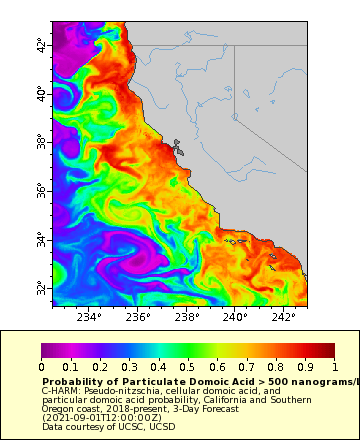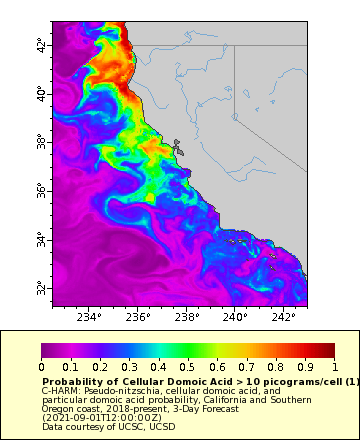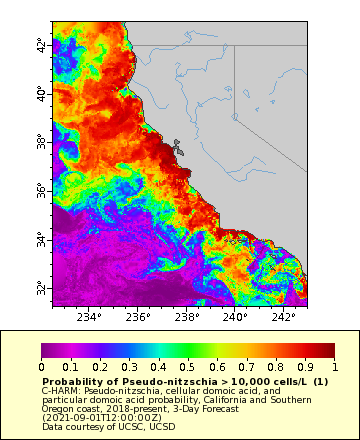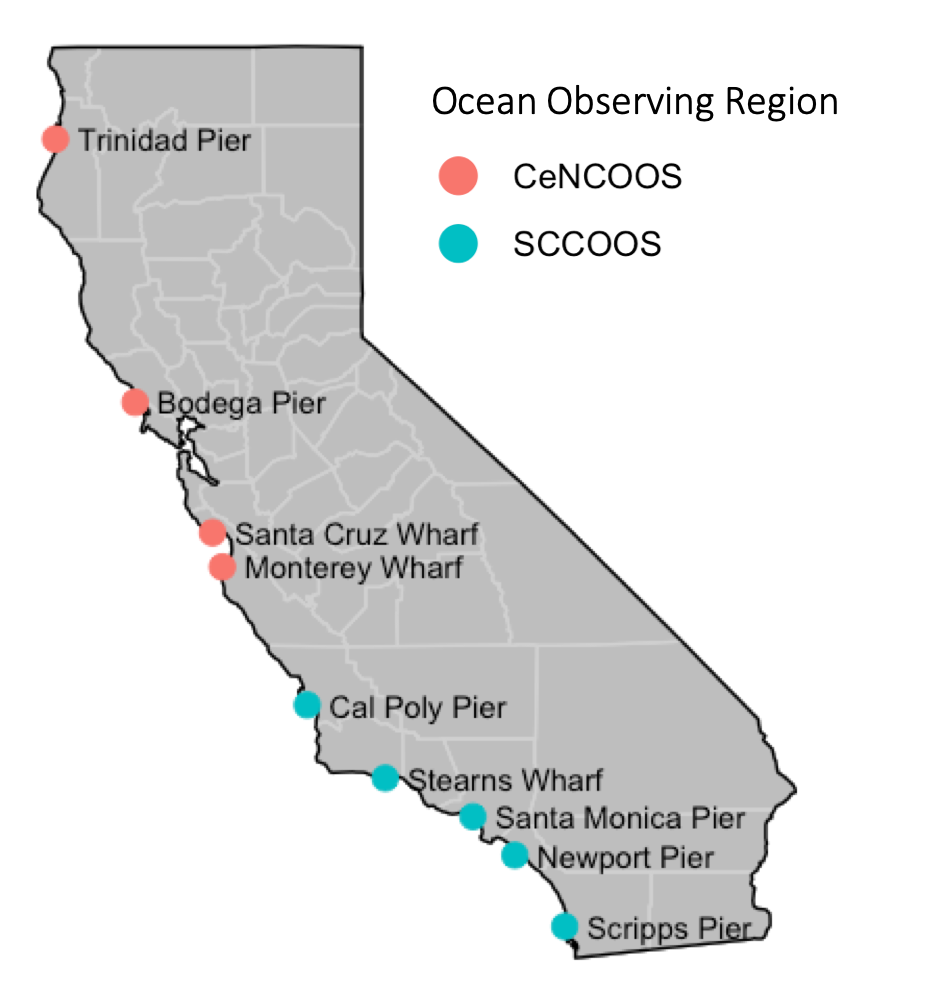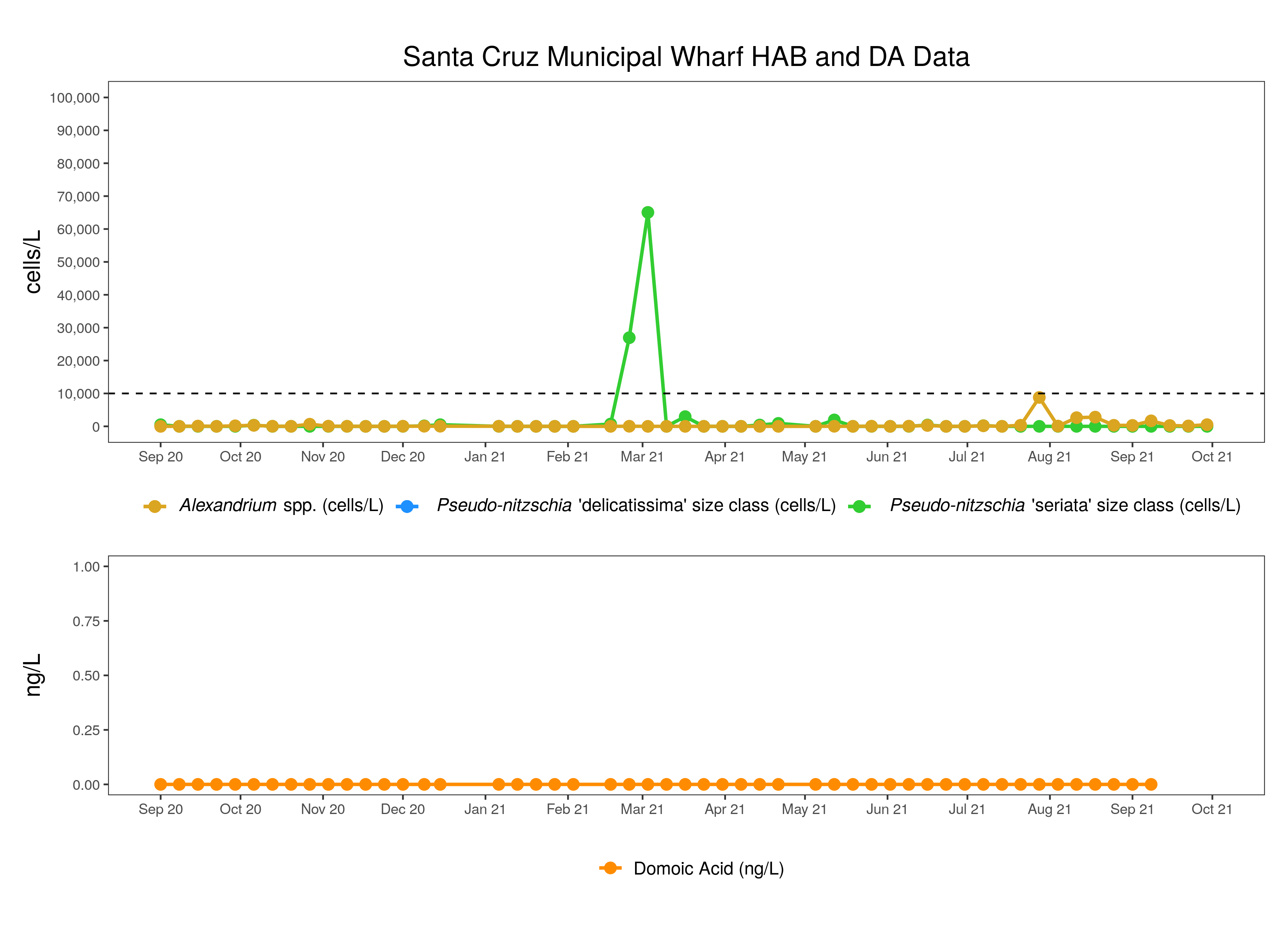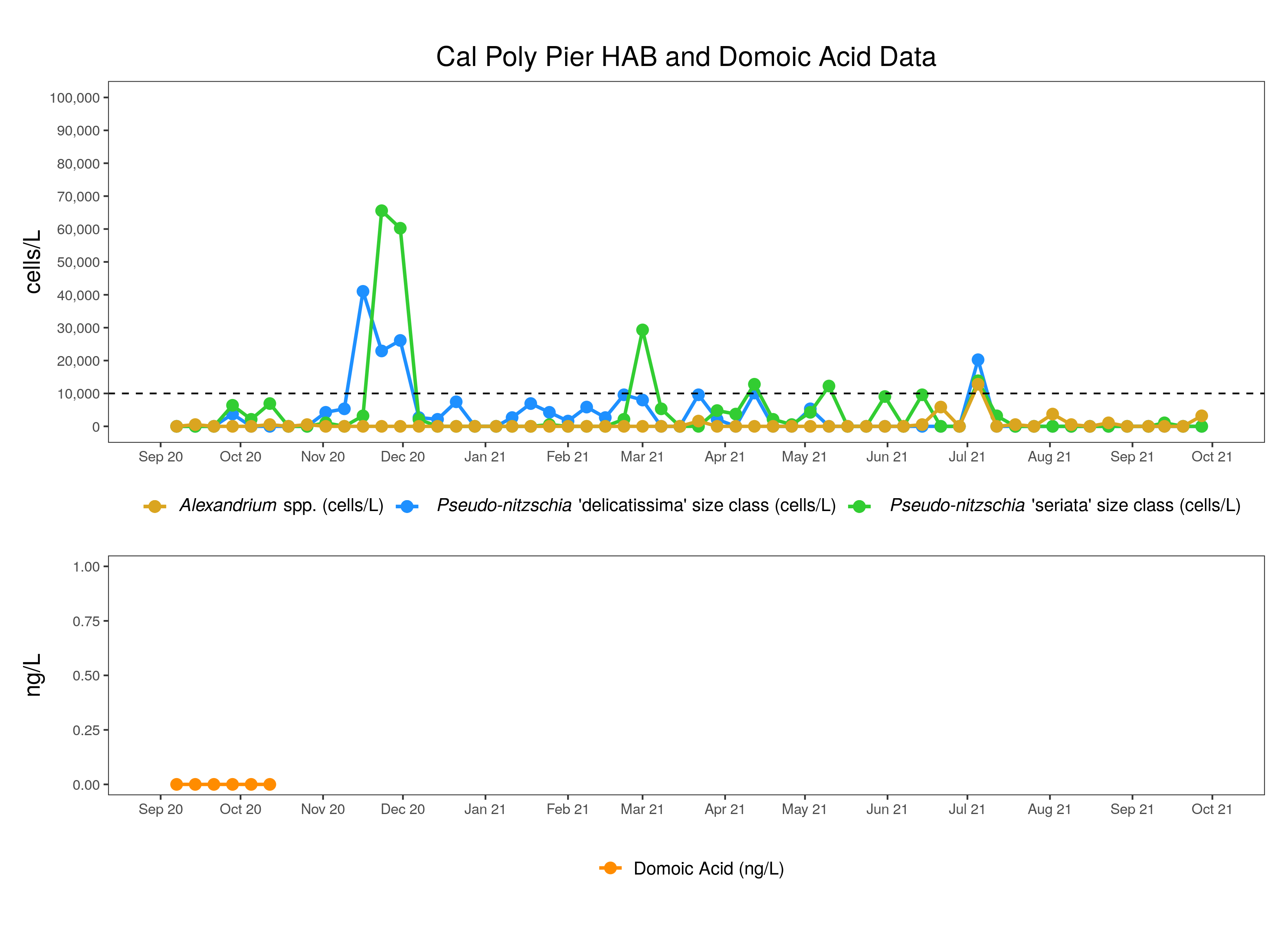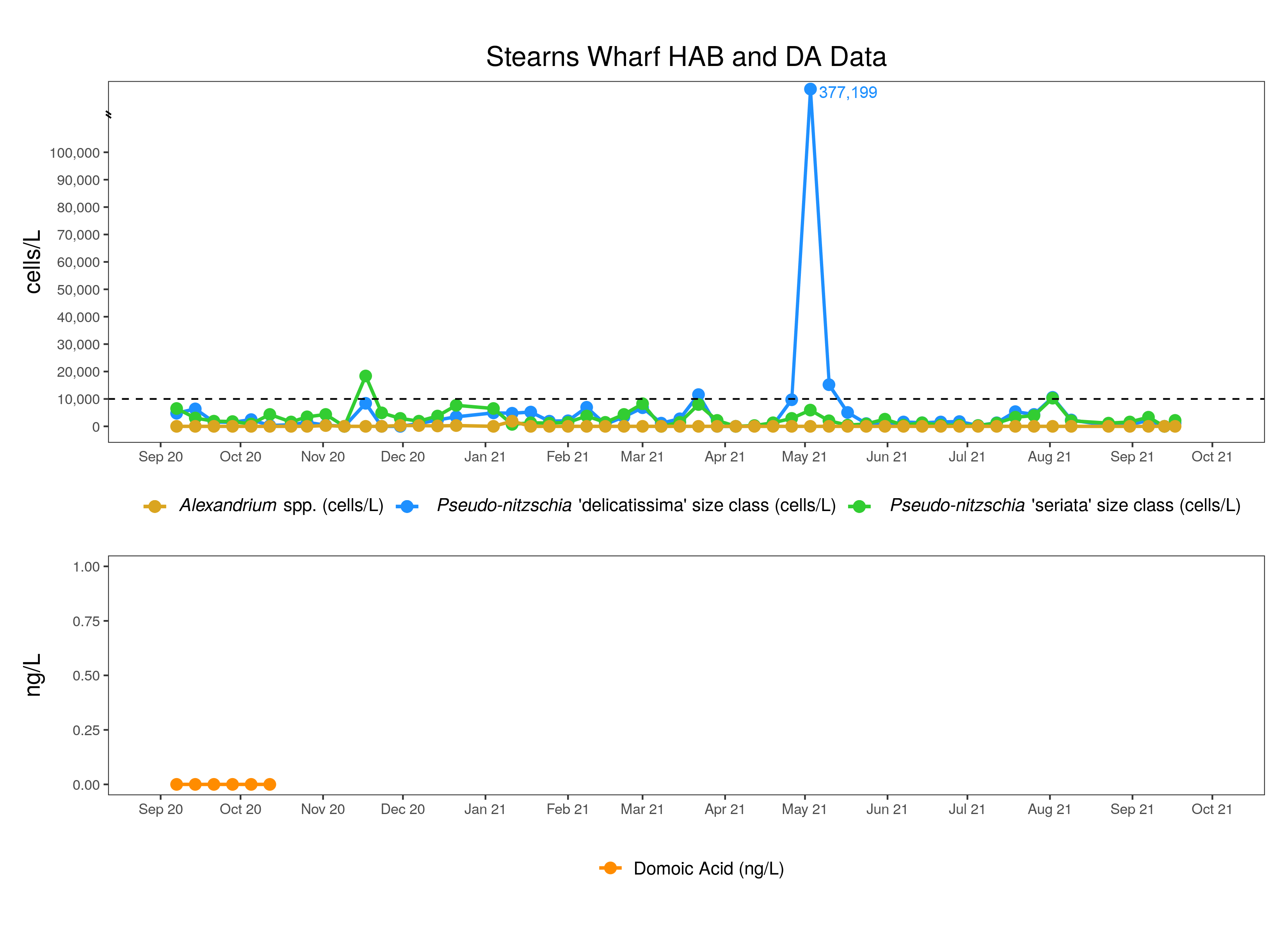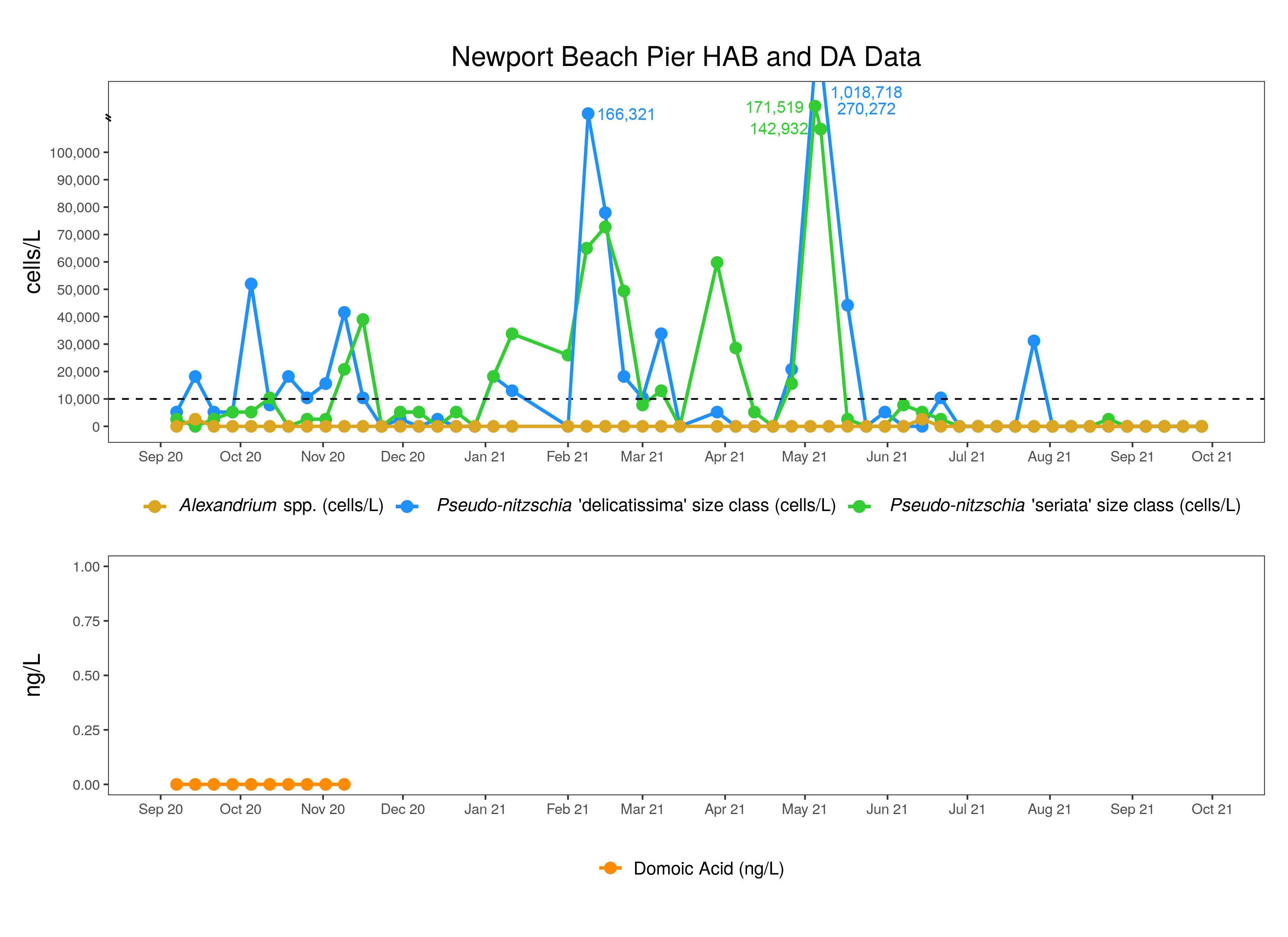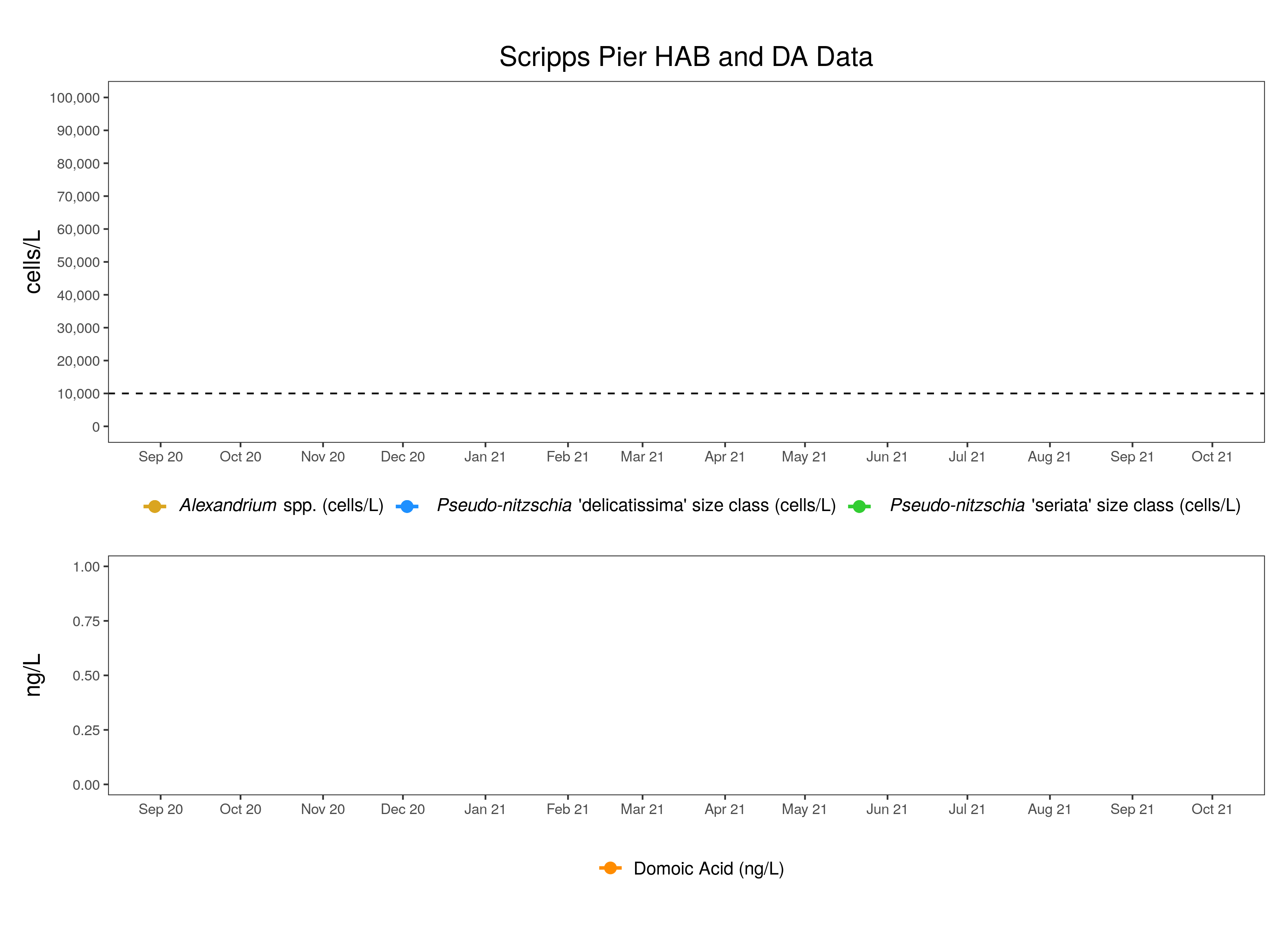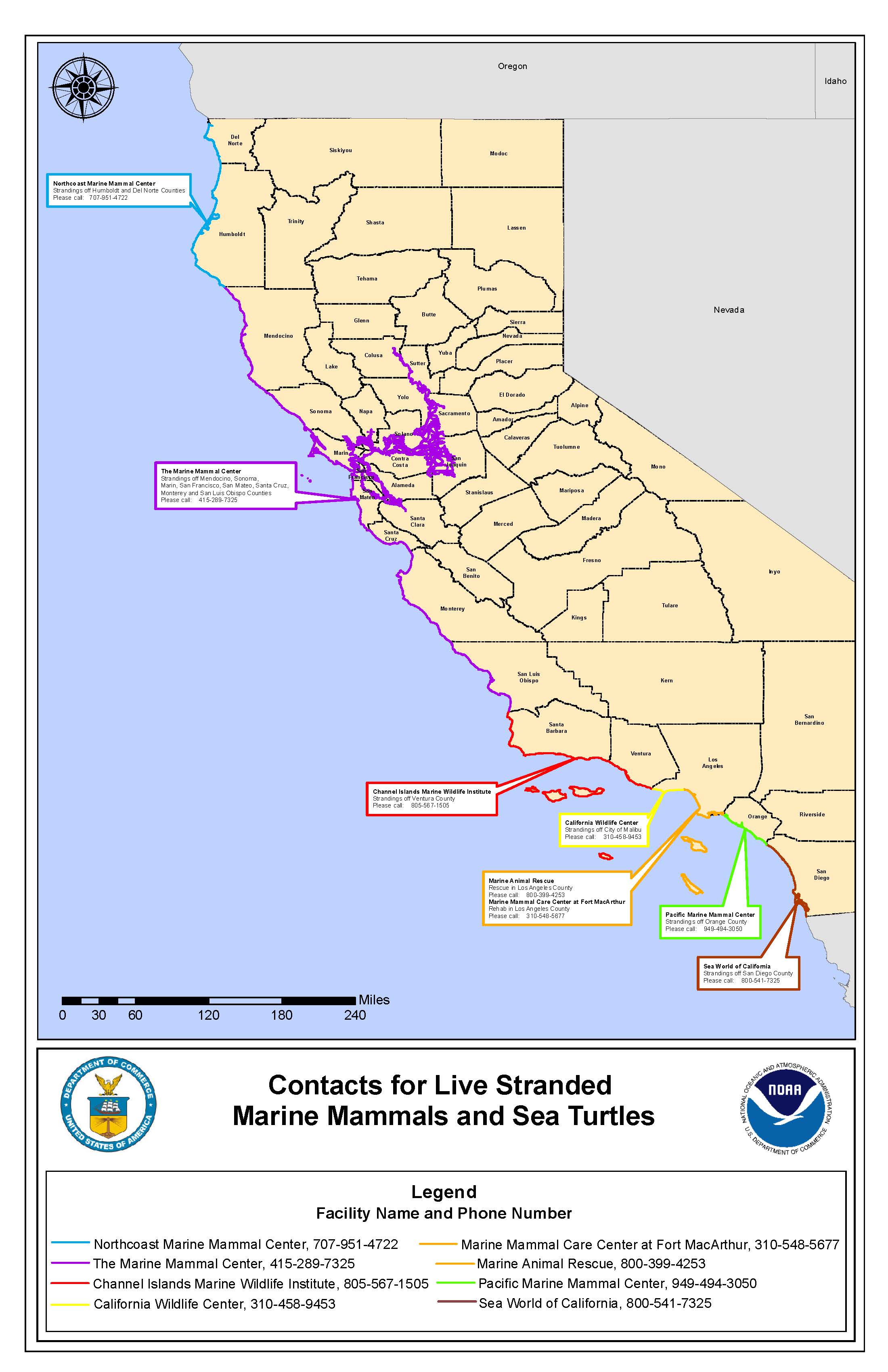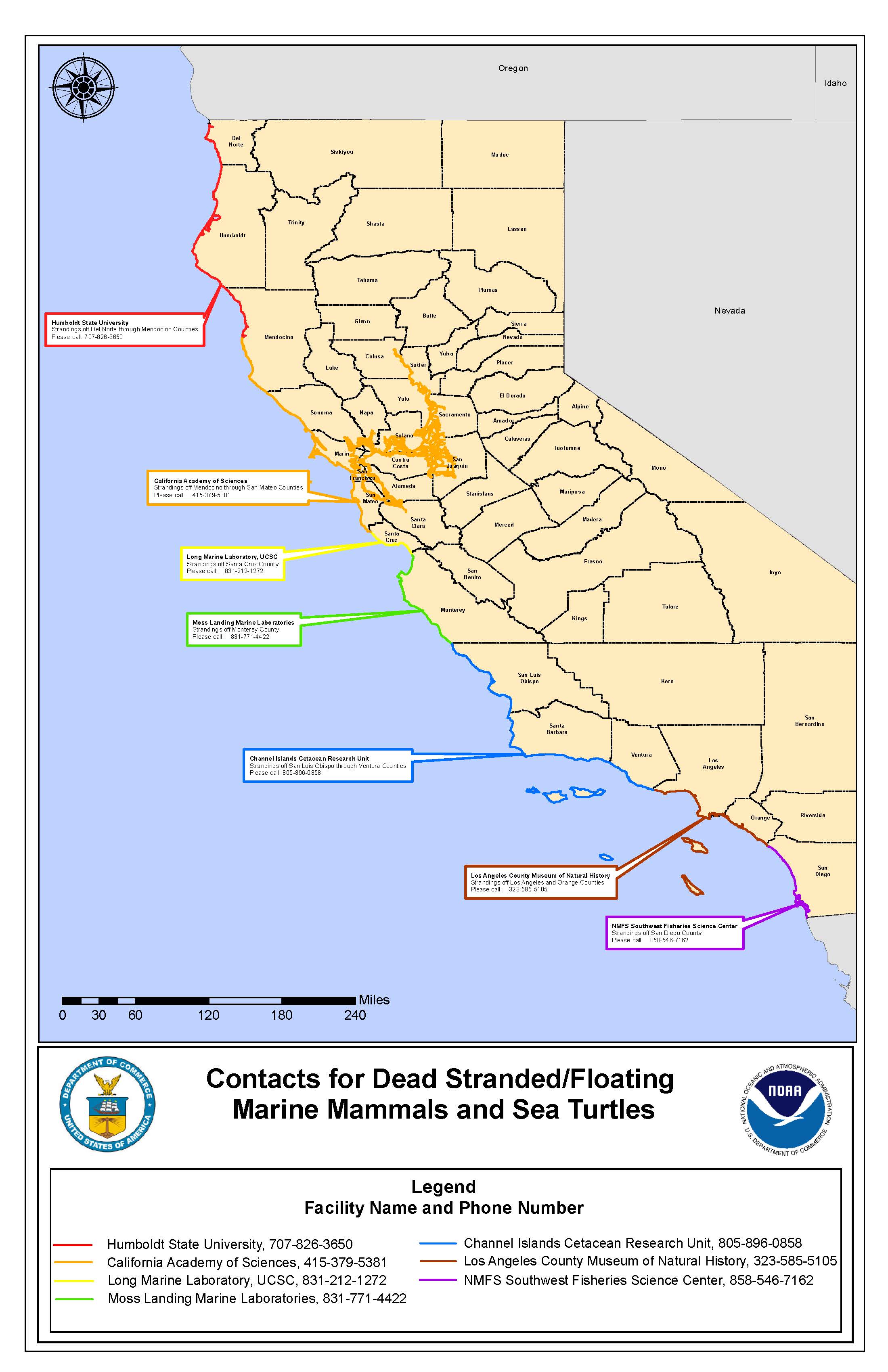Pseudo-nitzschia -
- C-HARM tells us where conditions are suitable for species of the diatom Pseudo-nitzschia spp. (all size classes) to grow well and where they might be more likely to produce the deadly neurotoxin, domoic acid (DA).
- C-HARM predictions in September suggest patchy habitat suitability for Pseudo-nitzschia spp. throughout the state, with a focus on central California and the regions around SF Bay as a particularly intense hotspot.
- There was no noteworthy Pseudo-nitzschia presence at any of the HABMAP pier sites where data were reported in September, similar to August.
- The Relative Abundance Index (RAI) for the Pseudo-nitzschia "seriata" size class recorded by the California Department of Public Health (CDPH) reached "Common" levels (10-49%) at Scripps Pier in La Jolla, two sites in the Santa Barbara Channel, Pacifica Pier (just outside SF Bay), and Trinidad Pier.
- Moderate to very high C-HARM probabilities (50-100%) for particulate domoic acid (pDA) were predicted for large sections of the California coastline in September with three main foci: northern California, central California region near SF and Monterey Bays (except for mid-September when probabilities in this region were very low), and the southern part of the Southern California Bight
- The highest probabilities for cellular DA (cDA) formed an obvious bolus in the North Coast region throughout the entire month of September, picking up from where August left off with highest cDA probabilities confined to the North Coast region. This suggests possible issues in that region at the start of Dungeness crab season.
- There were only two marine mammal strandings from potential DA toxicosis in September - one mid-month in Los Angeles and one at the end of Sept in Santa Cruz, consistent with very high pDA probabilities in southern California and low probabilities in central California early to mid-month that then reversed pattern later in the month.
- HABMAP pDA data are only so far available at Santa Cruz Wharf for the month of September, and no DA was detected, which again underscores the perennial mismatch between the very nearshore measurements at piers and what appears to be occurring offshore based on C-HARM predictions and marine mammal stranding events.
- No new shellfish warnings or closures for Amnesic Shellfish Poisoning were added in September
Alexandrium -
- CDPH noted that Alexandrium spp. were "Common" in Morro Bay (10% relative abundance index) in September, just as in August and July, suggesting an on-going threat there and consistent with HABMAP sampling at Cal Poly Pier on September 27th. The recreational shellfish advisory related to PSP that was issued for mussels in Marin County (just north of San Francisco) on August 27th is still in effect.
*Please note that HABMAP sampling, CDPH sampling, and marine mammal rescues have been greatly reduced in response to COVID-19 safety measures.
**HABMAP sampling resumed after being suspended in March 2020 in accordance with the Governor's stay at home order. However, COVID-19 safety protocols and sampling restrictions may continue to affect operations and delay results.**
Note that data for some stations are not shown because they are not yet recorded in the public HABMAP archive.
Differentiating Pseudo-nitzschia species by light microscopy is difficult. For this reason, Pseudo-nitzschia "seriata" does not refer to an actual species but rather the larger size class of Pseudo-nitzschia, which is generally a more toxigenic group of species. Alternatively, Pseudo-nitzschia "delicatissima" refers to the smaller size class that is generally non-toxigenic. The dashed line on the plots demarcates the 10,000 cells/L "bloom" threshold designated here for Pseudo-nitzschia populations only.
More information and data visualizations on the statewide HAB network and forecasting system can be found on the California HABMAP website and on the SCCOOS Harmful Algal Bloom page.
Santa Cruz Wharf
Five water samples were collected at Santa Cruz Wharf in September. Molecular probes for toxigenic Pseudo-nitzschia in the "seriata" class are conducted for this site, but was not detected. Alexandrium spp. were detected on each occasion (September 1, 8, 15, 22, 29). Domoic acid was not detected.
The Santa Cruz Wharf shore station is supported by CeNCOOS PI Raphael Kudela at UCSC.
Cal Poly Pier
Four water samples were collected at Cal Poly Pier in September. Pseudo-nitzschia "delicatissima" was not detected. Pseudo-nitzschia "seriata" was detected once on September 13 below the bloom threshold. Alexandrium spp. were detected on September 27. Domoic acid results are not yet available.
Cal Poly Pier shore station is supported by SCCOOS and PIs Ryan Walter and Ally Pasulka at Cal Poly.
Stearns Wharf
Three water samples were collected at Stearns Wharf in September. Pseudo-nitzschia "delicatissima" and Pseudo-nitzschia "seriata" were detected on September 7 and 17. Alexandrium spp. were not detected and domoic acid results are not yet available.
Stearns Wharf is supported by SCCOOS and PIs Mark Brzezinski and Libe Washburn at UCSB.
Santa Monica Pier
Four water samples were collected at Santa Monica Pier in September. Pseudo-nitzschia "delicatissima", Pseudo-nitzschia "seriata", and Alexandrium spp. were not detected. Domoic acid results are not yet available.
The Santa Monica Pier shore station is supported by SCCOOS and PI Rebecca Shipe at UCLA.
Newport Beach Pier
Four water samples were collected at Newport Beach Pier in September. Pseudo-nitzschia "delicatissima", Pseudo-nitzschia "seriata", and Alexandrium spp. were not detected. Domoic acid results are not yet available.
Newport Beach Pier is supported by SCCOOS and PI David Caron at USC.
Scripps Pier
Scripps Pier water samples are not available for April 2020 through September 2021.
Scripps Pier is supported by SCCOOS and PIs Melissa Carter and Clarissa Anderson at UCSD.
CDPH observations for Pseudo-nitzschia "seriata" and Alexandrium spp.
You can view the interactive map and data table of California Department of Public Health (CDPH) data from January 2019 to present, developed by SCCOOS, below. Or, view CDPH Toxic Phytoplankton Observations Map with layers of Pseudo-nitzschia and Alexandrium spp. as well as other phytoplankton species observations (in the pop-up windows).
Data are provided by the Environmental Management Branch of the CDPH. Please note, starting in July 2019, CDPH moved to only reporting Pseudo-nitzschia of the seriata complex and not all Pseudo-nitzschia spp. as previously provided.
Please email CDPH at Susan.Paulukonis@cdph.ca.gov for any potential marine HAB-related illness in humans.
From September 1-30 2021, water samples were collected by volunteers and sent to the California Department of Public Health (CDPH) for analysis.
Pseudo-nitzschia "seriata" group was detected in 40 of the 91 samples:
Pseudo-nitzschia "seriata" was detected at "Common" density levels on 3 occasions:
- 2021-09-18 15% GFNMS, Marin Line 2W
- 2021-09-18 44% GFNMS, Marin Line 2E
- 2021-09-24 20% GFNMS, Marin Line 4W
Pseudo-nitzschia "seriata" was detected at "Present" density levels on 26 occasions:
- 2021-09-01 6% Goleta Pier
- 2021-09-07 1% Tomales Bay, Lease #M430-15
- 2021-09-07 3% La Jolla, Scripps Pier
- 2021-09-07 5% Humboldt Bay, Indian Is. Ch.
- 2021-09-09 1% Bodega Harbor, USCG Dock
- 2021-09-09 7% Wilson Creek
- 2021-09-10 8% Port San Luis, Diablo Cove
- 2021-09-13 3% Morro Bay, Boat Launch
- 2021-09-13 7% Humboldt Bay, Indian Is. Ch.
- 2021-09-14 3% Mendocino, Noyo Harbor
- 2021-09-15 2% Goleta Pier
- 2021-09-15 5% Trinidad Pier
- 2021-09-17 5% Port San Luis, Diablo Cove
- 2021-09-19 1% Pacifica Pier
- 2021-09-19 4% GFNMS, Marin Line N11-WN
- 2021-09-19 4% GFNMS, Marin Line N2WN
- 2021-09-20 3% Tomales Bay, Lease #M430-15
- 2021-09-21 1% Santa Cruz Is., Prisoners Hrbr
- 2021-09-21 5% GFNMS, Marin Line 11E
- 2021-09-23 5% GFNMS, San Francisco Line 6W
- 2021-09-23 8% GFNMS, San Francisco Line 6E
- 2021-09-24 1% Richmond, Marina Bay Harbor
- 2021-09-24 1% San Simeon Pier
- 2021-09-24 2% GFNMS, Marin Line N4-WN
- 2021-09-27 1% Tomales Bay, Lease #M430-15
- 2021-09-27 4% Humboldt Bay, Indian Is. Ch.
Pseudo-nitzschia "seriata" was detected at "Rare" density levels on 11 occasions:
- 2021-09-07 0.5% Morro Bay, Boat Launch
- 2021-09-08 0.5% Ventura, Port Hueneme Pier
- 2021-09-09 0.5% Ventura, Offshore Station 3
- 2021-09-11 0.5% San Francisco, Presidio Pier
- 2021-09-13 0.5% Tomales Bay, Lease #M430-15
- 2021-09-20 0.5% Humboldt Bay, Indian Is. Ch.
- 2021-09-20 0.5% Morro Bay, Boat Launch
- 2021-09-21 0.5% Goleta Pier
- 2021-09-22 0.5% Monterey Bay, Commercial Wharf
- 2021-09-27 0.5% Morro Bay, Boat Launch
- 2021-09-29 0.5% Goleta Pier
Alexandrium spp. were detected in 29 of the 91 samples:
Alexandrium spp. were detected at "Abundant" density levels once:
- 2021-09-05 73% Morro Bay, North T-Pier
Alexandrium spp. were detected at "Common" density levels once:
- 2021-09-22 10% Monterey Bay, Commercial Wharf
Alexandrium spp. were detected at "Present" density levels on 9 occasions:
- 2021-09-02 6% Tomales Bay, Lease #M430-15
- 2021-09-10 8% Port San Luis, Diablo Cove
- 2021-09-17 8% Port San Luis, Diablo Cove
- 2021-09-20 8% Morro Bay, Boat Launch
- 2021-09-20 3% Morro Bay, Boat Launch
- 2021-09-21 5% San Luis Obispo, Cal Poly Pier
- 2021-09-27 3% Morro Bay, Boat Launch
- 2021-09-27 1% Tomales Bay, Lease #M430-15
- 2021-09-29 2% Goleta Pier
Alexandrium spp. were detected at "Rare" density levels on 18 occasions:
- 2021-09-01 0.5% Goleta Pier
- 2021-09-06 0.5% Santa Cruz Wharf
- 2021-09-07 0.5% Humboldt Bay, Indian Is. Ch.
- 2021-09-08 0.5% Goleta Pier
- 2021-09-09 0.5% Wilson Creek
- 2021-09-11 0.5% San Francisco, Presidio Pier
- 2021-09-13 0.5% Bolinas Lagoon
- 2021-09-13 0.5% Tomales Bay, Lease #M430-15
- 2021-09-13 0.5% Morro Bay, Boat Launch
- 2021-09-15 0.5% Goleta Pier
- 2021-09-15 0.5% Trinidad Pier
- 2021-09-18 0.5% GFNMS, Marin Line 2W
- 2021-09-18 0.5% GFNMS, Marin Line 2E
- 2021-09-19 0.5% Palos Verdes, OFFSHORE
- 2021-09-19 0.5% GFNMS, Marin Line N2WN
- 2021-09-21 0.5% GFNMS, Marin Line 11E
- 2021-09-22 0.5% Santa Cruz Wharf
- 2021-09-30 0.5% Ventura, Port Hueneme Pier
CDPH and OEHHA Health Advisories
October 5. The California Department of Public Health (CDPH) has lifted the August 27, 2021 shellfish safety notification related to sport-harvested clams and scallops in Marin County.
August 27. Dangerous levels of paralytic shellfish poisoning (PSP) toxins have been detected in mussels from Marin county.
April 30. The California Department of Public Health (CDPH) announced the annual quarantine of sport-harvested mussels gathered along the California coast.
For the latest closures and updates, please visit the CDPH Health Advisories page as a central location of information related to CDPH health advisories. Also available is a map showing the current CDPH Recreational Bivalve Shellfish Advisories (see below).
NEWS: The HAB-related illness workgroup has developed a new webpage for marine HAB-related illness tracking work (https://oehha.ca.gov/fish/general-info/marine-harmful-algal-bloom-hab-related-illness-tracking).
California Marine Mammal and Seabird Strandings from Suspected DA Toxicosis
Domoic acid (DA) is a potent neurotoxin produced by some diatom species of the genus Pseudo-nitzschia. Species exposed to DA can result in seizures, epilepsy, cardiomyopathy, and death depending upon the ingested dose. DA toxicosis commonly occurs in California Sea Lions (Zalophus californianus), presumably due to a combination of foraging behavior and seasonal movements. The Marine Mammal Center (TMMC), Channel Islands Marine Wildlife Institute (CIMWI), California Wildlife Center (CWC), Marine Mammal Care Center Los Angeles (MMCC-LA), Marine Animal Rescue (MAR), the Pacific Marine Mammal Center (PMMC), and SeaWorld act like an emergency room by working to rescue and rehabilitate sick and injured marine mammals, seabirds, and sea turtles.
Among the six rehabilitation centers we received data for in the month of September, 2 marine mammal strandings presented with symptoms of domoic acid toxicosis.
The CWC, PMMC, CIMWI and SeaWorld did not record any strandings due to suspected domoic acid in September 2021.
September strandings due to suspected DA toxicosis occurred in the following counties:
- Los Angeles (MCCLA)
- September 12 - adult, female, California Sea Lion
- Santa Cruz (TMMC)
- September 25 - juvenile, male, California Sea Lion

